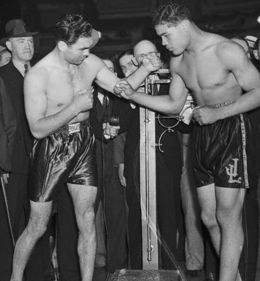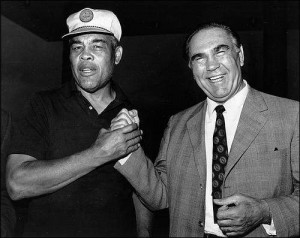Louis vs. Schmeling: When Sports Transcended Society
It is hard now more than 70 years later to fully appreciate the social and global significance of two boxing matches in June of 1936 and 1938 between a black man from Detroit, Michigan and a white man from Germany. However, at the time, Joe Louis and Max Schmeling were prominent figures on the global stage and represented very polarizing situations within the social consciousness of the day.
When they met for the first time 75 years ago on June 19, 1936, Joe Louis was the 22-year-old Louis was 27-0 and considered the number one contender for the Heavyweight Championship. At 30-years-old, Schmeling, a former Heavyweight Champion was thought to be on the downside of his career and given little chance to defeat the powerful Louis.
However, Schmeling claimed before the match that he had noticed a flaw in Louis’ style specifically in how he dropped his guard after throwing a punch. Sure enough, Schmeling stayed close and in the 12th round knocked out Louis.
The victory made Schmeling a hero in Hitler’s Germany of the mid-1930s while the loss was felt hard by blacks in America who had seen Louis as more than just a good fighter, but as a champion for the cause of black Americans at a time when there were very few black heroes. Schmeling’s victory was touted by Nazi officials as proof of their doctrine of Aryan superiority.
Despite the loss, Louis became Heavyweight Champion in 1937, but said he would not consider himself to be the true champion until he had avenged his defeat to Schmeling.
He got that opportunity in Yankee Stadium on June 22, 1938 when the two men met for the rematch. By this time, war was looming and though Schmeling personally had no connection to Hitler and the Nazi regime, he was portrayed as a German warrior.
On the other hand, though blacks in the United States were denied many rights at the time, Louis was portrayed as the defender of American freedoms.
Unlike in their first meeting, Louis was completely prepared for Schmeling. Louis was the aggressor from the very beginning and knocked Schmeling down three times in the two minute and four second fight. This time Schmeling didn’t have a chance to notice any flaw in Louis’ form as he threw just two punches in the fight. After the third knockdown, Schmeling’s trainer threw in the towel to end the fight.
The victory propelled Louis to an unparalleled period of boxing greatness. He was the Heavyweight Champion from 1937 until 1949. Though IRS issues forced him to return from retirement and suffer a pair of losses late in his career, he still won 65 of his 68 career fights.
Schmeling eventually became the European Heavyweight Champion, but he was drafted into the German Luftwaffe in 1939 and served in the military until the end of the war.
Ironically, in their later years Louis and Schmeling became friends and appeared together on television programs and at other events. While Louis’ struggled financially for the remainder of his life, Schmeling became a successful businessman. He even helped pay for Louis’ funeral in 1981 and served as a pall bearer. Schmeling died in 2005 at the age of 99.














